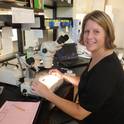The Deepwater Horizon Oil Spill (DWHOS) necessitated a whole-water-column approach for assessment that included the epipelagic (0–200 m), mesopelagic (200–1000 m), and bathypelagic (>1000 m) biomes. The latter two biomes collectively form the largest integrated habitat in the Gulf of Mexico (GOM). As part of the Natural Resource Damage Assessment (NRDA) process, the Offshore Nekton Sampling and Analysis Program (ONSAP) was implemented to evaluate impacts from the spill and to enhance basic knowledge regarding the biodiversity, abundance, and distribution of deep-pelagic GOM fauna. Over 12,000 cephalopods were collected during this effort, using two different trawl methods (large midwater trawl [LMT] and 10-m2 Multiple Opening and Closing Net Environmental Sensing System [MOC10]). Prior to this work, 93 species of cephalopods were known from the GOM. Eighty cephalopod species were sampled by ONSAP, and additional analyses will certainly increase this number as hard-to-identify taxa are resolved. Of these species, seven were previously unknown in the GOM, including two probable undescribed species. Because additional work is continuing using only the MOC10, cephalopod species composition of the LMT and MOC10 trawls are compared here for possible differences in inferred diversity and relative abundance. More than twice as many specimens were collected with the LMTs than the MOC10, but the numbers of species were similar between the two gear types. Each gear type collected eight species that were not collected by the other type.
Article
Diversity of midwater cephalopods in the northern Gulf of Mexico: Comparison of two collecting methods.
USF St. Petersburg campus Faculty Publications
Document Type
Article
Publication Date
2017
Disciplines
Abstract
Publisher
Springer
Creative Commons License
Creative Commons Attribution-Noncommercial-No Derivative Works 4.0
Citation Information
Judkins, H.L., Vecchione, M., Cook, A.B., & Sutton, T.T. (2016). Diversity of midwater cephalopods in the northern Gulf of Mexico: Comparison of two collecting methods. Marine Biodiversity, 1-11. doi: 10.1007/s12526-016-0597-8.

Abstract only. Full-text article is available through licensed access provided by the publisher. Published in Marine Biodiversity, 1-11. doi: 10.1007/s12526-016-0597-8. Members of the USF System may access the full-text of the article through the authenticated link provided.